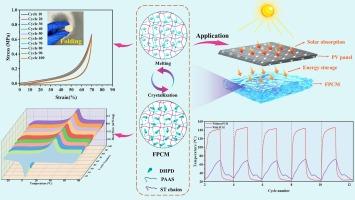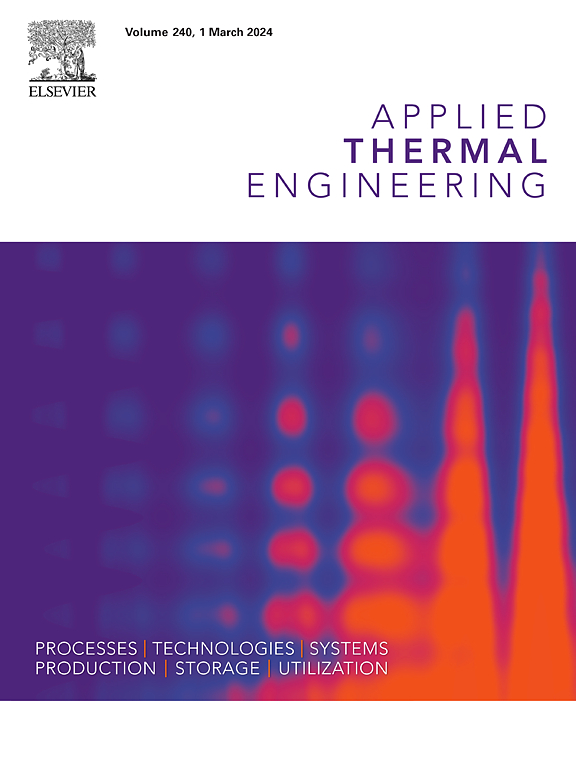开发用于光伏面板温度控制的柔性相变储热材料
IF 6.1
2区 工程技术
Q2 ENERGY & FUELS
引用次数: 0
摘要
光伏(PV)发电技术在实现人类长期可持续发展目标方面发挥着至关重要的作用,并已在全球范围内得到广泛应用。然而,光伏电池的效率会受到温度波动的影响,因此可以通过降低光伏板的表面温度来提高能量转换效率。无机相变材料具有高相变潜热、优异的温度控制性能和不可燃性等优点,因此在太阳能储存和热管理领域的应用前景十分广阔。无机相变材料的实际应用受到高刚性、易断裂和形状不稳定等问题的阻碍。针对这些问题,本文将优化的十二水磷酸氢二钠(DHPD)与聚丙烯酸钠(PAAS)和淀粉(ST)结合,制备出一种新型 PAAS/ST/DHPD 柔性相变水凝胶。当 DHPD 含量为 65 wt% 时,相变温度为 31.0 °C,变化潜热为 162.3 J/g。此外,该水凝胶在经过 100 次加热-冷却循环后表现出优异的热稳定性,并在 25 °C 和 40 °C 温度下表现出良好的抗压性能。研究还评估了复合材料对光伏板的冷却效果,结果表明光伏板的温度显著降低,应用前景广阔。本文章由计算机程序翻译,如有差异,请以英文原文为准。

Development of flexible phase-change heat storage materials for photovoltaic panel temperature control
Photovoltaic (PV) power generation technology plays a crucial role in achieving humanity’s long-term sustainable development goals and has been widely utilized worldwide. However, the efficiency of PV cells is affected by temperature fluctuations, and enhancing energy conversion efficiency can be achieved by reducing the surface temperature of PV panels. Inorganic phase change materials offer advantages such as a high latent heat of phase change, excellent temperature control performance, and non-flammability, making them highly promising for applications in solar energy storage and thermal management. Practical applications of inorganic phase change materials are hindered by issues such as high rigidity, susceptibility to fracture, and unstable shape. To address these issues, this paper combines optimized disodium hydrogen phosphate dodecahydrate (DHPD) with sodium polyacrylate (PAAS) and starch (ST) to prepare a new type of PAAS/ST/DHPD flexible phase change hydrogel. The phase change temperature is 31.0 °C, with a latent heat of change of 162.3 J/g when the DHPD content is 65 wt%. Furthermore, the hydrogel demonstrates excellent thermal stability after 100 heating–cooling cycles and exhibits good compression-resilience properties at both 25 °C and 40 °C. The study also evaluates the cooling effect of the composite material on PV panels, showing a significant reduction in panel temperature and promising application prospects.
求助全文
通过发布文献求助,成功后即可免费获取论文全文。
去求助
来源期刊

Applied Thermal Engineering
工程技术-工程:机械
CiteScore
11.30
自引率
15.60%
发文量
1474
审稿时长
57 days
期刊介绍:
Applied Thermal Engineering disseminates novel research related to the design, development and demonstration of components, devices, equipment, technologies and systems involving thermal processes for the production, storage, utilization and conservation of energy, with a focus on engineering application.
The journal publishes high-quality and high-impact Original Research Articles, Review Articles, Short Communications and Letters to the Editor on cutting-edge innovations in research, and recent advances or issues of interest to the thermal engineering community.
 求助内容:
求助内容: 应助结果提醒方式:
应助结果提醒方式:


